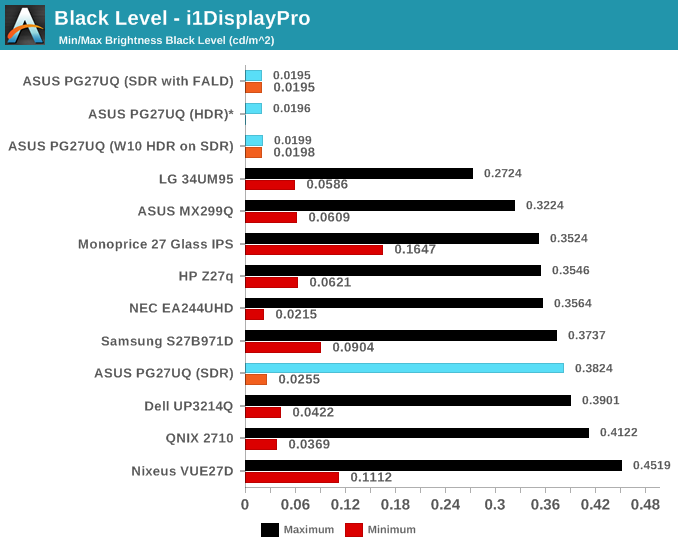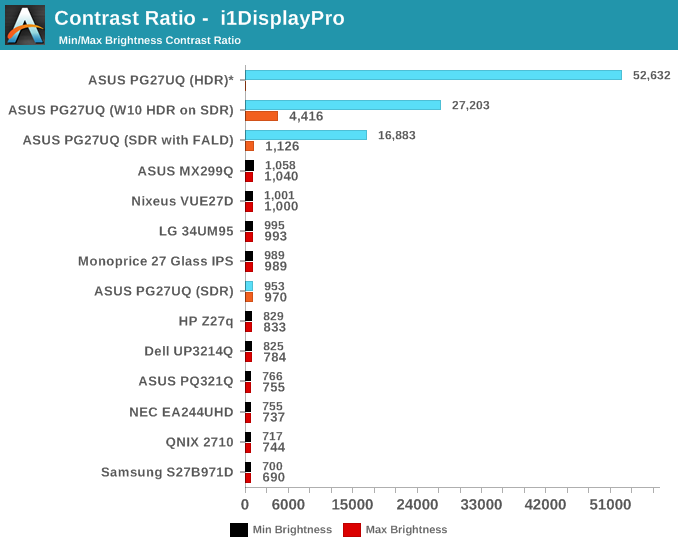The Asus ROG Swift PG27UQ G-SYNC HDR Monitor Review: Gaming With All The Bells and Whistles
by Nate Oh on October 2, 2018 10:00 AM EST- Posted in
- Monitors
- Displays
- Asus
- NVIDIA
- G-Sync
- PG27UQ
- ROG Swift PG27UQ
- G-Sync HDR
Brightness and Contrast
Going straight into the brightness and contrast metrics, we know HDR's calling card is to permit those bright whites and dark blacks. For DisplayHDR 1000, and UHD Premium, 1000 nits (the common non-SI term for cd/m2) is the requirement. So for brightness of white levels, it's no surprise that in HDR mode the PG27UQ reaches that coveted mark.
Outside of HDR, brightness is also useful in gauging visibility/usability in conditions of bright and direct ambient light, i.e. outdoors. For moderately lit indoor use, the typical 200 to 300 nit range of desktop monitors is more than sufficient. In terms of factory defaults, the PG27UQ is set at 80 for brightness, which is around 266 nits. 1000 nits is much too bright for day-to-day usage, as is 500 nits.

*In HDR mode, there is an adjustable 'reference white' setting, defaulted at 80 nits, instead of a brightness setting. At that default setting, the PG27UQ displayed the HDR test pattern at 1032 nits.
Because HDR has a static 'reference white' level instead of brightness, there isn't really an equivalent to minimum brightness white level as it isn't utilized in the same way; for the PG27UQ, reference white can be set between 20 to 300 nits.
Otherwise, enabling the Windows 10 'HDR and Wide Color Gamut' mode puts the monitor into its HDR mode; additionally, that Windows 10 setting provides a brightness slider governing SDR content while in HDR mode. So at 100% SDR brightness, the display pushes past 500 nits. For users, it works nicely to avoid SDR dimness when HDR is enabled, and also providing the option to boost up to much higher brightness if desired.

*Represents black levels corresponding to the default 'reference white' setting of 80 nits.
IPS-type panels are often known for their 'backlight bleed' and so relatively higher black levels. Without its local dimming capability, the PG27UQ isn't much of an exception. Enabling variable backlighting (FALD) in the OSD brings the black levels to HDR tier performance, and can be enabled on SDR mode at the cost of maximum brightness white levels.

*Contrast ratios calculated from default reference white of 80 nits
The good range between bright whites and dark blacks translate into high contrast ratios for the PG27UQ. While we don't have any other HDR monitors for comparison, the contrast ratios are really in their own class, especially as only HDR content will take advantage of the brightness and be (properly) displayed. Otherwise, in pure SDR mode, the PG27UQ resembles a solid IPS-type SDR monitor. Just enabling the direct LED backlighting in SDR mode improves contrasts considerably on the strength of its black levels.










91 Comments
View All Comments
crimsonson - Tuesday, October 2, 2018 - link
Someone can correct me, but AFAIK there are no native 10 bit RGB support in games. 10-bit panel would at least improve its HDR capabilities.FreckledTrout - Tuesday, October 2, 2018 - link
The games that say they are HDR should be using 10-bit color as well.a5cent - Wednesday, October 3, 2018 - link
Any game that supports HDR uses 10 bpp natively. In fact, many games use 10 bpp internally even if they don't support HDR officially.That's why a HDR monitor must support the HDR10 video signal (that's the only way to get the 10 bpp frame from the GPU to the monitor).
OTOH, a 10 bit panel for gaming typically won't provide a perceptible improvement. In practice, 8bit+FRC is just as good. IMHO it's only for editing HDR still imagery where real 10bit panels provide benefits.
GreenReaper - Thursday, October 4, 2018 - link
I have to wonder if 8-bit+FRC makes sense on the client side for niche situations like this, where the bandwidth is insufficient to have full resolution *and* colour depth *and* refresh rate at once?You run the risk of banding or flicker, but frankly that's similar for display FRC, and I imagine if the screen was aware of what was happening it might be able to smooth it out. It'd essentially improve the refresh rate of the at the expense of some precise accuracy. Which some gamers might well be willing to take. Of course that's all moot if the card can't even play the game at the target refresh rate.
GreenReaper - Thursday, October 4, 2018 - link
By client, of course, I mean card - it would send an 8-bit signal within the HDR colour gamut and the result would be a frequency-interpolated output hopefully similar to that possible now - but by restricting at the graphics card end you use less bandwidth, and hopefully it doesn't take too much power.a5cent - Thursday, October 4, 2018 - link
"I have to wonder if 8-bit+FRC makes sense on the client side for niche situations like this"It's an interesting idea, but I don't think it can work.
The core problem is that the monitor then has no way of knowing if in such an FRC'ed image, a bright pixel next to a darker pixel correctly describes the desired content, or if it's just an FRC artifact.
Two neighboring pixels of varying luminance affect everything from how to control the individual LEDs in a FALD backlight, to when and how strongly to overdrive pixels to reduce motion blur. You can't do these things in the same way (or at all) if the luminance delta is merely an FRC artifact.
As a result, the GPU would have to control everything that is currently handled by the monitor's controller + firmware, because only it has access to the original 10 bpp image. That would be counter productive, because then you'd also have to transport all the signaling information (for the monitor's backlighting and pixels) from the GPU to the monitor, which would require far more bandwidth than the 2 bpp you set out to save 😕
What you're thinking about is essentially a compression scheme to save bandwidth. Even if it did work, employing FRC in this way is lossy and nets you, at best, a 20% bandwidth reduction.
However, the DP1.4(a) standard already defines a compression scheme. DSC is lossless and nets you about 30%.That would be the way to do what you're thinking of.
Particularly 4k DP1.4 gaming monitors are in dire need of this. That nVidia and Acer/Asus would implement chroma subsampling 4:2:2 (which is also a lossy compression scheme) rather than DSC is shameful. 😳
I wonder if nVidia's newest $500+ g-sync module is even capable of DSC. I suspect it is not.
Zoolook - Friday, October 5, 2018 - link
DSC is not lossless, it's "visually lossless", which means that most of the time you shouldn't percieve a difference compared to an uncompressed stream.I'll reserve my judgement until I see some implementations.
Impulses - Tuesday, October 2, 2018 - link
That Asus PA32UC wouldn't get you G-Sync or refresh rates over 60Hz and it's still $975 tho... It sucks that the display market is so fractured and people who use their PCs for gaming as well as content creation can't get anything approaching perfect or even ideal at times.There's a few 4K 32" displays with G-Sync or Freesync but they don't go past 60-95Hz AFAIK and then you don't get HDR, it's all a compromise, and has been for years due to competing adaptive sync standards, lagging connection standards, a lagging GPU market, etc etc.
TristanSDX - Tuesday, October 2, 2018 - link
Soon there will be new PG27UC, with mini led backlight (10000 diodes vs 384) and with DSCDanNeely - Tuesday, October 2, 2018 - link
Eventually, but not soon. AUO is the only panel company working on 4k/high refresh/HDR; and they don't have anything with more dimming zones on their public road map (which is nominally about a year out for their production, add a few months to it for monitors makers to package them and get them to retail up once they start volume production of panels).